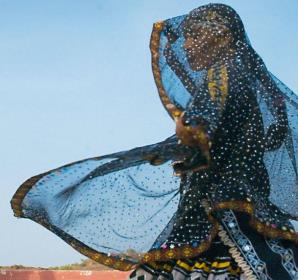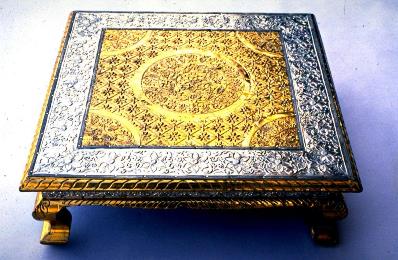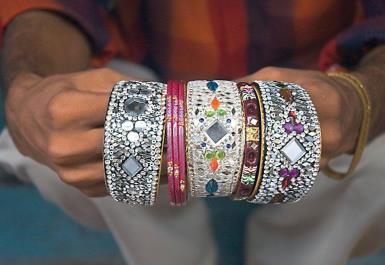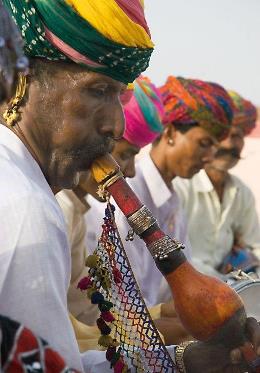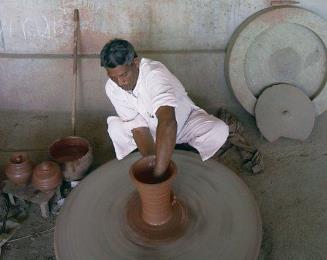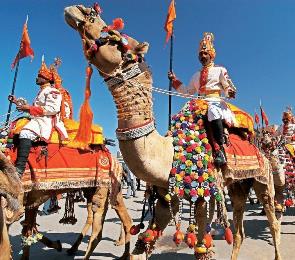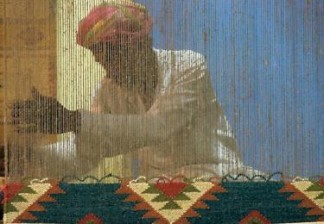
 Departure December Annually
Departure December Annually
The Rann Utsav is called “heaven on earth” because the full moon casts its light over the desert creating a white milky color over all the desert landscape enhancing a “heavenly feeling”. Add visits to the numerous indigenous tribes throughout Gujarat and you have a tribal adventure. See cultural dance, hear folk music as you watch adorned camels offer transport and celebratory rides. Learn about Gujarat villages and their arts and crafts which provide a major source of income for the Rabaris, Mirs, Bharvads and the Dagasias tribes. Tribal Gujarat w/Rann Ustav will take you out of this world!
Day 1 – Arrive Ahmedabad
Arrive this evening at Ahmedabad International airport. Our representative would meet you outside the customs gate. You will be escorted to your hotel in an air-conditioned vehicle.
Ahmedabad: (also called Amdavad) is capital of Gujarat and a major city, and a startling mini-metropolis. Straddling the Sabarmati River, its one half old-world charm and the other half new-world noise. Yet it’s also remarkably cosmopolitan, with a rich Muslim history, a tangled, beautifully restored old city, stunning museums, fine restaurants and fabulous night markets. Overnight in Ahmedabad Meals Included: Dinner
Day 2 – Ahmedabad
Today we start our day with a heritage walk of Ahmedabad city. The walk begins from the picturesque Swaminarayan Mandir in Kalupur and ends in the most glorious architectural legacies the Jumma Masjid, covering in between the numerous pols, havelis, ornamental facades, workplaces of artisans and number of magnificent Hindu and Jain temples. Our walk effectively anchored by our volunteer Rajesh Gajjar, proceeds from Kavi Dalpatram Chowkto the Calico Dome to the century old Kala Ramji Mandir in the Haja Patel ni Pole with a unique idol of Lord Rama in dark color and in a sitting posture. After lunch, visit Sidi Saiyed Mosque, Shaikh Ahmed Khattu , Sheryas Art Museum , Hutheesingh Jain Temple and the Gandhi Ashram
Siddi Saiyed Mosque: One part of the wall in the old citadel of the mosque built by Ahmed Shah’s slave, Sidi Sayed, is celebrated the world over for its exquisite stone window tracery – a superb & peerless example of delicate carving that transforms stone into filigree.
Shreyas Folk Museum: Shreyas Folk Museum is an educational museum exhibiting folk arts and crafts of Gujarat. It is located 2.5km west of Sabarmati in the suburbs of Ahmedabad district. As the name suggests, the exhibits at the museum include art, craft, textile and clothing, coins, weapons, toys, costumes, masks, puppets and musical instruments. One of the highlights at this museum is a complete elephant skeleton (3.19m high). The museum is open from 10.30am to 1.30pm and from 2.00pm to 5.30pm on all days except Mondays and public holidays. Photography is not allowed.
Hutheesingh Jain Temple: Built outside the Delhi Gate in 1850 by a rich Jain merchant, the Hutheesing Temple is the best known of Ahmedabad’s many ornate Jain temples.
Gandhi Ashram: On a quiet peaceful stretch of the Sabarmati river, Mahatma Gandhi set up a simple retreat in 1915. This was his Satyagrah Ashram and for many years it was the nerve center of India’s freedom movement. It was from here, in 1930, that Mahatma began his famous Dandi March to the sea to protest against the Salt Tax imposed by the British. Hridaya Kunj, the simple cottage where he lived, is now a national monument and preserved as it was during the Mahatma’s life-time. Dinner will be at nice local restaurant. Overnight in Ahmedabad
Meals included: Breakfast, Lunch & Dinner
Day 3 – Ahmedabad
Early morning visit Jama Mosque. This mosque exhibits the finest example of the 2nd period of Gujarat’s Provincial Architectural development, built by Ahmad Shah I, founder of the city, in 1423. The striking feature of this mosque is the facade which has a screen flanked by pillared portico. Continue to the east of the entrance of the Jami Masjid and visit the Teen Darwaza (triple gateway), the Royal Tombs of Ahmad Shah I and the Queens of Ahmad Shah. Continuing east and southeast visit the buildings from the third Gujarati Muslim Period. Also visit nearby fruits and vegetables markets. Return to the hotel for breakfast and relax at the hotel. Leave the hotel for lunch at nice local restaurant. Post lunch visit Adalaj Stepwell.
Adalaj Step Well or Adalaj ni Vav as it is known is Gujarati is a magnificent example of Indo-Islamic architecture in Gujarat. Located at a distance of 18kms away from Ahmedabad city in the quiet village of Adalaj in Gandhinagar district – the Adalaj Step Well is a must-visit not only for its superb architecture but also for its intricate carvings on the wall that add to the character of this step well.
The Adalaj Step Well was built in 1499 by Queen Rudabai as a resting place for travelers, villagers and pilgrims visiting the area. The five-storey step well was built to serve not only as a cultural and a utilitarian space but also as a spiritual refuge for the villager s who came every morning at the well to fill water, offer prayers to the deities carved on the walls and to interact with each other under the cool shade of the vav or step well.
Apart from the fact that this is the only step well in entire Gujarat that has three entrance stairs, the Adalaj Step Well is popular for its architecture, which is a harmonious blend of intricate Islamic floral patterns, which seamlessly fuse into Hindu and Jain motifs symbolizing the cultural ethos of that era. Return to the hotel to relax. Dinner at the hotel. Overnight in Ahmedabad Meals included: Breakfast, Lunch & Dinner
Day 4 – Ahmedabad – Dasada
This morning leave for Dasada covering distance of 100 Kms in approx 2 hours, en route stop to visit Bahuchar Mata Temple (THIRD GENDER TEMPLE) it is the temple to the mother goddess bahuchar the temple is frequented by many hijras and third gender people of Gujarat and other states. The main festival here is Navratri celebrated four times a year. Continue overland for Dasada. On Arrival check in at your hotel.
Rann Riders: is an ethnically designed eco-resort, set among wetlands and agricultural fields. The resort has imaginatively designed cottages that blend with the rural countryside in which it is situated. Located near Dasada village, it makes the ideal base to explore the culture, weaves and handicrafts of the Surendranagar district. Lunch at the hotel. Post lunch you would be taken for jeep ride inside tribal villages for shoot during sunset.
Rabari: Myths and legends haunt the history and origins of the Rabari in Gujarat, as mysterious as any other tribe, whose lifestyle has intrigued many researchers. Related to Shiva, which according to legend, descended through their ancestor Sambal, are one of the last nomadic peoples of the world. Even today, ancient routes traverse through the arid plains of the Thar Desert, in northwest India in search of pasture for their flocks. Ethnicity from Afghanistan, is the largest pastoral community of Kutch. The men, tall, thin, often with long moustaches, their heads wrapped in turbans predominantly light in color, wearing white pants tight at the ankles and a jacket, also white, tight and pleated chest. Ear, as a distinctive sign, a gold earring filigree (tolyia).
While men lead their flocks to pasture, the women always treated with great respect within the family, dealing dell’allestimento of huts and children wearing colorful damask coats and baggy trousers. The women, who wear beautiful clothes elaborate, are very skilled in embroidery fabrics and blankets and even leather, while the men inlay work on wood and silver and copper crafts is a very rich, whose techniques were passed down generation to generation, making the famous Kutch. Each village has its specialties: Hodka to the Harijan work the leather in the KoliNerona produce beautiful works of lacquer and dye the fabric with the technique of “rogan”.
Characteristic of Rabari are colorful, embellished with embroidered waistcoats, men and women wearing jewels of gold and silver finely crafted, rings, bracelets and earrings of various forms. Often men who are less vain women, than women in the ornaments themselves. These, however, beat them for their beauty and poise delicate and elegant. Dinner will be at hotel. Overnight in Dasada Meals included: Breakfast, Lunch & Dinner
Day 5 – Dasada
This morning we will leave by our jeeps to see salt workers and the sections of the sanctuary visited depends on the interests of patrons. To meet locals, the safaris head to the salt pans. The marshlands and Nava Talao (lake) are crowded with water birds. Flamingos and demoiselle cranes can usually be spotted in hundreds at some water bodies. The Indian wild ass and white-footed fox can be sighted on vast areas of golden ground. Look out for the rare hoopoe lark, which has brown plumage that allows it to camouflage itself perfectly in the ground. Since there are no trees or shrubs to act as a buffer between the vehicles and the wildlife, it is not possible to get too close to the animals. Return to the hotel. Post lunch we ride once again into our jeeps to shoot for other local tribal villages.
Mirs: On the periphery of Dasada lives a community of 15 families of nomadic Mirs. Their dress is Rajasthani; their homes are temporary. Traditionally they kept the genealogy of Rabaris. The Rabaris would pay them in kind – goats or sheep- to record their births, marriages and deaths. The Mirs used to also draw what was given in exchanges between Rabari families.
Mirs migrated with Rabaris, keeping relations with them according to Rabari lineages. Each Mir was in charge of a particular lineage or sakh. Today, some 10,000 Mirs live all over Gujarat – all the way to Mumbai, Sattarbhai declares. They no longer live in Rajasthan but live particularly in Vagad, eastern Kutch, and north Gujarat.
Women wear aniyo (a short, backless blouse), kurti (a front closing sleeveless jacket) ghagharo (a 20 meter gathered skirt), and chundadi (a 5 meter veil). Most striking are their ornaments: copious necklaces and tassels fashioned from beads, coins and trinkets, and in particular their white bangles from wrist to armpit. Mir men wear white pachedo (a wrapped lower garment) and kamiz (a shirt)
Though Muslim, each Mir has both a Hindu and a Muslim name. Today Mirs do manual agricultural and construction labour. The women are expert in beadwork and in Dasada they have started making beaded bangles.
Bharvads: Bharvads originated in Mathura. They were traditionally maldhari, or nomadic herders, and have kept sheep, goats, cows and buffalo. In Mathura, it was the Bharvads who raised the refugee infant Krishna. Bharvads came to the Dasada area looking for grass. Bharvads have Barots who keep their genealogical records.
With their intimate connection to Krishna, the Bharvads’ main celebration is Janamashtami, the birthday of Lord Krishna. On that day, they make a clay image of kanudo, the child Krishna. They decorate the image, dance around it, and finally immerse it in a body of water. Bharvads gather for marriage during the Tarnetar Fair.
Women wear tangalio (wrapped skirt) and galmendi (veil), both woven from the wool of their sheep, with a khinkhab (brocade) kapadu (short backless blouse). The galmendi was traditionally bandhani, symbolizing suhag, the auspicious state of a married woman. embroidered, sometimes also using wool. Married women also wore balaiyun (bracelets) of silver, and when a son was married and a daughter-in- law arrived, exchanged these for ivory versions. Men wear a blue, green or red bori (wrapped lower garment) with a machine embroidered bandi (vest) and kediyun (ruffled jacket), and a red melkhayu (turban). Most notably they wear gold upper earrings, both tansiya (rings) and phul (umbrella-like studs), and silver kadu (bracelets) and kanduro (belt). Dinner will be at hotel. Overnight in Dasada Meals included: Breakfast & Dinner
Day 6 – Dasada
Today we will divide ourselves into two groups to cover rest of tribal villages.
Dangasias: Closely associated with the Bharvads are the Dangasia, traditional weavers. The two communities share a symbiotic relationship. Bharvads keep sheep, and Dangasias weave the wool into garments for the Bharvads. Moreover, Dangasia dress is the same as that of Bharvads. As with the Mirs and Rabaris, the connection is not coincidental.
They traditionally weave tangalio and galmendi, Bharvad women’s dress, as well as dhabla, woolen blankets used by many local communities. Dangasias are devout believers in Chamunda Devi, the form of the goddess Parvati, whose main temple is in Chotila. On the 8th day of Navaratri, in October, they gather to worship this goddess.
Jats: Landholders in Bajana near Dasada for centuries, the Jats also have a pastoral nomadic history. Jats of this region wear the dress of Rajputs, and practiced the regional styles of embroidery. Dinner will be at hotel. Overnight in Dasada Meals included: Breakfast, Lunch & Dinner
Day 7 – Dasada – Bhuj
This morning leave for Bhuj , approx 275 Kms /5hrs drive. This beautiful old walled city, Bhuj virtually leaps out from the pages of the Arabian Nights. Lose yourself for hours in the maze of narrow streets and colorful bazaars, and admire the Kutchi people dressed in their heavily embroidered traditional costumes. Late afternoon, proceed to visit Bhuj town and local market. Sunset visit at Hamrir Lake.
Hamirsar Lake is where people go to swim, or sit under a tree and enjoy the water, as well as where many women do their laundry. Walking along the lake’s edge is a great way to get from one place to another, with the Aina Mahal and Praga Mahal, the Kutch Museum, the Ramkund Stepwell and Ram Dhun Temple, the Swaminarayan Temple and the Alfred High School all located very close to the eastern side of the lake; a walk from the Aina Mahal to the Swaminarayan Temple (passing all the other sites mentioned) takes about half an hour. Further around the other side of the lake is the Sharad Baug. palace, and the road to the royal chhatardis. Dinner will be at hotel. Overnight in Bhuj Meals included: Breakfast, Lunch & Dinner
Day 8 – Bhuj
Early morning visit nearby fruits and vegetables markets. Return to hotel for breakfast. After visit Kutch villages (Bhujjodi-Padhar-Dhaneti- Dhamanka-Lilpur-Anjar-Dholavira) which offer a cultural extravaganza.
The villages of the Kutch region each specialize in a diffrent form of handicraft, and it would be easy to spend a week visiting some of them using Bhuj as a base.. Some of the more important villages include Bhujjodi (wool and cotton weaving), Padhar and Dhaneti (Ahir embroidery), Dhamanka ( block printing), Lilpur (embroidery) and Anjar (nut-crackers, block printing and tie-dyeing). Dholavira is a little village on a small island north-east of Bhuj. Here archeologists have unearthed a city belonging to the Harappan (Indus Valley) civilization. Due to their proximity to the Pakistan broder, you will require a permit signed by the Bhuj District Collector (see Permits in the Buj section for details) to visit the villages north of Bhuj. Bhuj tourist office’s map indicates which villages you can visit with or wihtout permission. When visiting these villages, be sensitive to local customs and sensibilities, eg wear clothes that cover your knees, and ask before photographing people. Dinner will be at hotel.
Overnight in Bhuj Meals included: Breakfast, Packed lunch & Dinner
Day 9 – Bhuj – Rann of Kutch
Very early morning visit of Cenotaphs Near Hamirsar Lake. The cenotaphs of rulers is a picturesque place. Featured in Bollywood movies, the place and garden around it makes for a nice time. Return to hotel for breakfast. Checkout and drive to Little Rann of Kutch , en route visit Banni Villages (North Bhuj)
Amidst the desert land of infinite dimensions, are suspended, quaint little villages. These are the last villages on the India-Pakistan border. Here you will come across master craft people’ exposing their traditional art, turning our master pieces every day. Their ornaments, clothes, utensils, everything they use – will make you feel as if you have stepped into lifestyle museum leaving you spellbound. Continue overland for Rann Utsav Tent City
Check in at your tented accommodation for next two days. Evening attend cultural program and night activities, followed by dinner. Overnight in Rann Meals included: Breakfast, Lunch & Dinner
Day 10 – Rann of Kutch (Festival)
Experience The Kutch at its colorful and exotic best during the Rann Festival. This annually organized festival offers an opportunity for visitors to attend Folk Dance, desert festival Kutch, desert festival Gujarat, desert festival India, Camel Safari, Live-in -Tents, Musical Moments, Visit the Centuries and many more activities. You can watch artisans at work, to shop directly from NGO’s craftspeople and village co-operatives, see the great historical monuments in the state, and visit places off the beaten path.
Kutch is considered to be a haven for numerous handicrafts, which are carried on from generation to generation. The traditional basis of its prosperity has been its foreign trade in various handicrafts. Overnight in Rann Meals included: Breakfast, Lunch & Dinner
Day 11- Rann of Kutch – Muli
Today we drive to Muli covering approx 249 Kms / 5hrs, en route visit Morbi Morbi, a small town of Gujarat State. Morbi is one of the wealthy cities in India. Wall clocks and Ceramic industries of Morbi have put the effort to make Indian Business more pride. In Either way, visiting Morbi will be one memory that you will cherish forever. Continue for Muli
The Parmar Rajputs were the ruling family of the princely state of Muli which had an area of 340 sq kms in Kathiawar. The ruler of the state held the title of Thakor and belonged to the Agnikula branch of Rajputs. The Thakors of Muli are of the Sodha Parmar Clan and claim descent from the line to which the celebrated Raja Vir Vikramaditya, Raja Bhoj and Raja Jagdev Parmar belong. The Parmars, whose original home was at Thar Parkar in Sindh, entered the peninsula of Kathiawar in about 1470-1475. The territory is famous for the battle fought between the Parmars and the Chahbads for a wounded partridge. The Princely State of Muli was one of the original constituent members of the Chamber of Princes. After the independence of India in 1947, the princely state of Muli was acceded to the newly formed Union of India. Overnight at Muli Meals Included: Breakfast, lunch & dinner.
Day 12 – Muli
Today proceed to visit Muli nearby villages and wooden Havelis. Also visit to 2nd Oldest Swaminarayan Temple in the World, Famous Wooden Haveli, Mandavraiji Sun Temple, Jhombai Temple with War Memorial & Famous Ancestral Stepwell. Overnight at Muli Meals Included: Breakfast, Lunch & Dinner
Day 13 – Muli
This morning we proceed to Ahemdabad covering approx in 3 hours and 150 Kms. Check into the hotel. Relax at hotel enjoy the hotel facilities. Overnight in Ahmedabad Meals Included: Breakfast, Lunch, Dinner
Day 14 – Depart Ahmedabad
Today in transfer to the International airport for your flight homebound.
